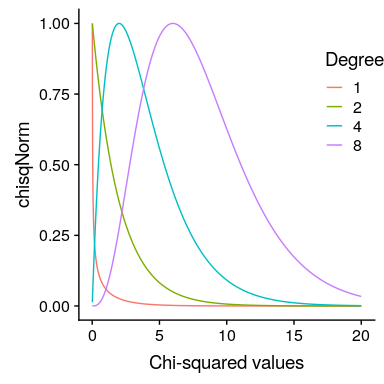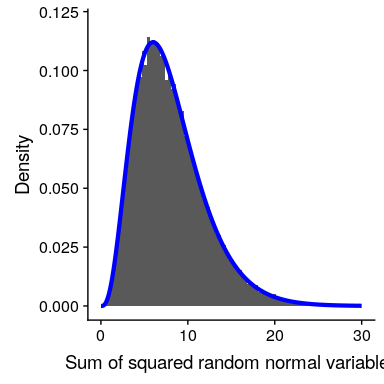## 12.2 皮尔逊卡方检验
皮尔逊卡方检验为我们提供了一种方法来检验观察到的计数数据是否与定义零假设的某些特定预期值不同:

在我们的糖果例子中,无效假设是每种糖果的比例是相等的。我们可以计算我们观察到的糖果计数的卡方统计,如下所示:
```r
# compute chi-squared statistic
nullExpectation <- c(1 / 3, 1 / 3, 1 / 3) * sum(candyDf$count)
chisqVal <-
sum(
((candyDf$count - nullExpectation)**2) / nullExpectation
)
```
这个分析的卡方统计结果是 0.74,这本身是不可解释的,因为它取决于加在一起的不同值的数量。然而,我们可以利用这样一个事实:卡方统计量是根据零假设下的特定分布分布分布的,这就是所谓的 _ 卡方 _ 分布。这种分布被定义为一组标准正态随机变量的平方和;它有若干自由度,等于被加在一起的变量数。分布的形状取决于自由度的数量。图[12.1](#fig:chisqDist)显示了几种不同自由度的分布示例。

图 12.1 不同自由度的卡方分布示例。
让我们通过模拟来验证卡方分布是否准确地描述了一组标准正态随机变量的平方和。
```r
# simulate 50,000 sums of 8 standard normal random variables and compare
# to theoretical chi-squared distribution
# create a matrix with 50k columns of 8 rows of squared normal random variables
d <- replicate(50000, rnorm(n = 8, mean = 0, sd = 1)**2)
# sum each column of 8 variables
dMean <- apply(d, 2, sum)
# create a data frame of the theoretical chi-square distribution
# with 8 degrees of freedom
csDf <-
data.frame(x = seq(0.01, 30, 0.01)) %>%
mutate(chisq = dchisq(x, 8))
```
图[12.2](#fig:chisqSim)显示,理论分布与重复将一组随机正态变量的平方相加的模拟结果非常吻合。

图 12.2 平方随机正态变量和的模拟。柱状图是基于 5 万组 8 个随机正态变量的平方和;蓝线显示了 8 个自由度下理论卡方分布的值。
对于糖果的例子,我们可以计算在所有糖果的相同频率的零假设下,我们观察到的卡方值为 0.74 的可能性。我们使用自由度等于 k-1(其中 k=类别数)的卡方分布,因为我们在计算平均值以生成预期值时失去了一个自由度。
```r
pval <- pchisq(chisqVal, df = 2, lower.tail = FALSE) #df = degrees of freedom
sprintf("p-value = %0.3f", pval)
```
```r
## [1] "p-value = 0.691"
```
这表明,观察到的糖果数量并不是特别令人惊讶的,基于印刷在糖果袋上的比例,我们不会拒绝等比的无效假设。
- 前言
- 0.1 本书为什么存在?
- 0.2 你不是统计学家-我们为什么要听你的?
- 0.3 为什么是 R?
- 0.4 数据的黄金时代
- 0.5 开源书籍
- 0.6 确认
- 1 引言
- 1.1 什么是统计思维?
- 1.2 统计数据能为我们做什么?
- 1.3 统计学的基本概念
- 1.4 因果关系与统计
- 1.5 阅读建议
- 2 处理数据
- 2.1 什么是数据?
- 2.2 测量尺度
- 2.3 什么是良好的测量?
- 2.4 阅读建议
- 3 概率
- 3.1 什么是概率?
- 3.2 我们如何确定概率?
- 3.3 概率分布
- 3.4 条件概率
- 3.5 根据数据计算条件概率
- 3.6 独立性
- 3.7 逆转条件概率:贝叶斯规则
- 3.8 数据学习
- 3.9 优势比
- 3.10 概率是什么意思?
- 3.11 阅读建议
- 4 汇总数据
- 4.1 为什么要总结数据?
- 4.2 使用表格汇总数据
- 4.3 分布的理想化表示
- 4.4 阅读建议
- 5 将模型拟合到数据
- 5.1 什么是模型?
- 5.2 统计建模:示例
- 5.3 什么使模型“良好”?
- 5.4 模型是否太好?
- 5.5 最简单的模型:平均值
- 5.6 模式
- 5.7 变异性:平均值与数据的拟合程度如何?
- 5.8 使用模拟了解统计数据
- 5.9 Z 分数
- 6 数据可视化
- 6.1 数据可视化如何拯救生命
- 6.2 绘图解剖
- 6.3 使用 ggplot 在 R 中绘制
- 6.4 良好可视化原则
- 6.5 最大化数据/墨水比
- 6.6 避免图表垃圾
- 6.7 避免数据失真
- 6.8 谎言因素
- 6.9 记住人的局限性
- 6.10 其他因素的修正
- 6.11 建议阅读和视频
- 7 取样
- 7.1 我们如何取样?
- 7.2 采样误差
- 7.3 平均值的标准误差
- 7.4 中心极限定理
- 7.5 置信区间
- 7.6 阅读建议
- 8 重新采样和模拟
- 8.1 蒙特卡罗模拟
- 8.2 统计的随机性
- 8.3 生成随机数
- 8.4 使用蒙特卡罗模拟
- 8.5 使用模拟统计:引导程序
- 8.6 阅读建议
- 9 假设检验
- 9.1 无效假设统计检验(NHST)
- 9.2 无效假设统计检验:一个例子
- 9.3 无效假设检验过程
- 9.4 现代环境下的 NHST:多重测试
- 9.5 阅读建议
- 10 置信区间、效应大小和统计功率
- 10.1 置信区间
- 10.2 效果大小
- 10.3 统计能力
- 10.4 阅读建议
- 11 贝叶斯统计
- 11.1 生成模型
- 11.2 贝叶斯定理与逆推理
- 11.3 进行贝叶斯估计
- 11.4 估计后验分布
- 11.5 选择优先权
- 11.6 贝叶斯假设检验
- 11.7 阅读建议
- 12 分类关系建模
- 12.1 示例:糖果颜色
- 12.2 皮尔逊卡方检验
- 12.3 应急表及双向试验
- 12.4 标准化残差
- 12.5 优势比
- 12.6 贝叶斯系数
- 12.7 超出 2 x 2 表的分类分析
- 12.8 注意辛普森悖论
- 13 建模持续关系
- 13.1 一个例子:仇恨犯罪和收入不平等
- 13.2 收入不平等是否与仇恨犯罪有关?
- 13.3 协方差和相关性
- 13.4 相关性和因果关系
- 13.5 阅读建议
- 14 一般线性模型
- 14.1 线性回归
- 14.2 安装更复杂的模型
- 14.3 变量之间的相互作用
- 14.4“预测”的真正含义是什么?
- 14.5 阅读建议
- 15 比较方法
- 15.1 学生 T 考试
- 15.2 t 检验作为线性模型
- 15.3 平均差的贝叶斯因子
- 15.4 配对 t 检验
- 15.5 比较两种以上的方法
- 16 统计建模过程:一个实例
- 16.1 统计建模过程
- 17 做重复性研究
- 17.1 我们认为科学应该如何运作
- 17.2 科学(有时)是如何工作的
- 17.3 科学中的再现性危机
- 17.4 有问题的研究实践
- 17.5 进行重复性研究
- 17.6 进行重复性数据分析
- 17.7 结论:提高科学水平
- 17.8 阅读建议
- References
